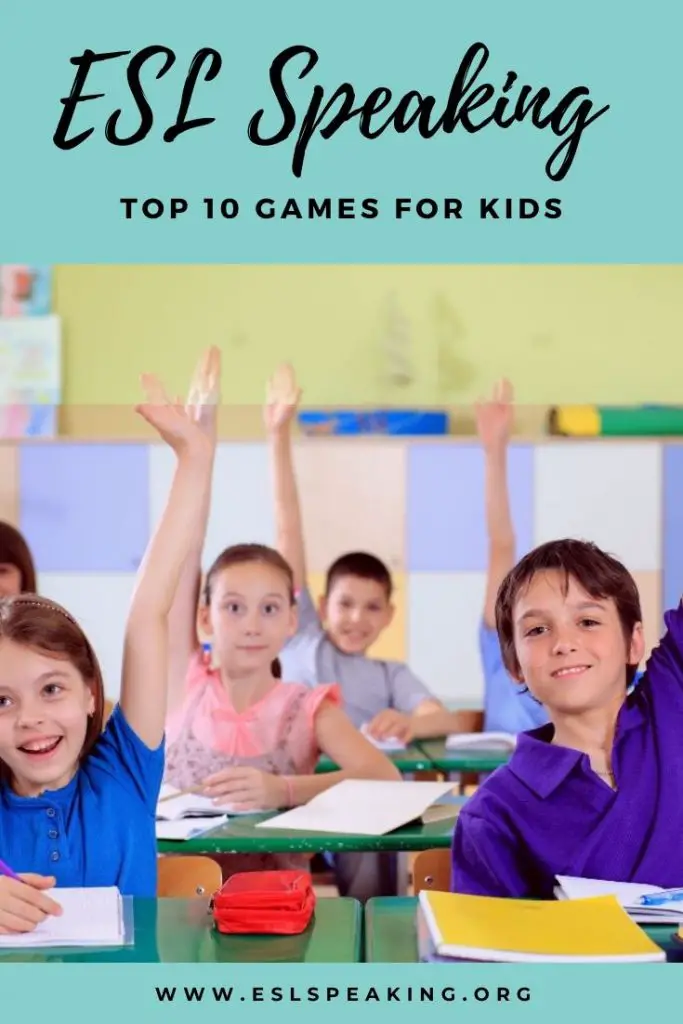Let’s be real. Teaching English to kids sometimes isn’t easy. They are often not that interested in speaking English to each other, or to you! That’s why you’ll need a variety of speaking activities for kids to keep things fresh and interesting.
Check out these fun ESL speaking games for children that are engaging, interactive and student-centred. Your students will love them and keep coming back for more of these speaking games for kids.

Kids ESL Speaking Activities and Games
A variety of fun, engaging speaking games for kids is the key to success. Keep on reading for my top picks for speaking games for kids that are proven to work in the ESL classroom.
Best Kids ESL Speaking Games
If you’re looking for some fresh new ideas for Kids ESL speaking games, you’ve come to the right place. Here are my top games that I like to use in my own classes. These ESL activities for children are guaranteed to make your life easier because you can plan interesting, engaging and fun lessons without spending a lot of time on it.
I know you’re tired of searching around on the Internet for the good stuff, right? Search no more for kids speaking activities.
Try out some of these kids ESL speaking games in your classes today! Your students will be happy, engaged and learning English. You’ll be able to plan your lessons quickly with a few top-quality ESL activities in them. Let’s get to the best TEFL talking games for kids.
#1: Password
Password is a fun ESL speaking game that is challenging, interesting and fun. It makes an excellent way to review some vocabulary that you’ve taught at the end of the class. You can also use this a warm-up at the beginning of the next one. I love to review vocabulary with my students and this is a great way to do that.
Check out this post for more details: Password ESL Speaking Game.
#2: Disappearing Text
If you’re looking for a fun filler activity that helps students remember vocabulary and sentence structure, try out this game. You write up a full sentence on the board, and gradually erase it, word by word. The challenge is that students have to remember what disappeared and say it back to you. It’s also an excellent way to catch any sort of pronunciation mistakes that your students might be making.
More details: Disappearing Text Game.
- Amazon Kindle Edition
- Smith, Jennifer Booker (Author)
- English (Publication Language)
- 85 Pages - 12/24/2015 (Publication Date)
#3: Charades Kids Speaking Game
If you’re looking for a fun ESL game for a party or activity class, you’ll need to try out charades. It’s a sneaky way to review some vocabulary as well and is probably more beneficial for the students than just playing Uno or something like that. I love to review in a fun, engaging way and this ESL game does just that.
More details about how to set this activity up: Charades ESL Speaking Game.

Speaking activities for primary students
#4: Find Someone Who Speaking Bingo
If you want to have some fun and help your students get to know each other at the beginning of the semester, you’ll need to try out this version of Bingo. It’s one of my favourite Kids ESL speaking games and I use it in most of my classes. It’s a nice variation on traditional Bingo because the kids are up out of their seats, moving around and talking to their classmates. It actually requires students to be active, instead of being very passive as they usually are in traditional Bingo.
More details: Find Someone Who Bingo Game.
#5: ESL Board Games
I love to play board games in real life, so I make my students play ESL ones in my classes. They always have a really fun time and want to play again the next time! You can make ESL board games for just about any sort of grammatical concept and they only take a few minutes to make once you get the hang of it.
Quick tips: have a small prize for the winner in each group to make it a bit more fun. To “roll” the dice, it can be pretty loud with actual dice. I get each group to use two coins instead. 2 heads =5, 1 head, 1 tail = 3, 2 tails = 1.
Check out this short video where I explain how I use ESL board games in my own classes.
#6: Chain Spelling
A fun way to review key vocabulary words is to play chain spelling. Not only is it great for review but it also has the added advantage of requiring absolutely nothing in the way of preparation or materials. It’s always nice to have a few of these in the back pocket, right?
Want to know more? Here are the details you need:
ESL Chain Spelling Activity for Kids.
#7: ESL Presentations for Children
If your students are a bit older and more advanced in their English skills, then you might consider incorporating some presentations into your classes. Even simple ones that require speaking for 30 seconds to 1 minute can be a valuable exercise.
There are plenty of topics and ideas for presentations to choose from here:
- Amazon Kindle Edition
- Bolen, Jackie (Author)
- English (Publication Language)
- 51 Pages - 09/11/2015 (Publication Date)
#8: Would You Rather ESL Speaking Game for Kids
If you’re looking for a quick speaking activity that’s ideal for a warm-up, then consider trying out Would you Rather? For example, would you rather break your right arm or left leg?
The way it works is that students have to choose between two options and then explain why they made that choice. Students can make their own questions for a partner or you can make a list for them to ask each other. Want to know more? Find out all the details here:
ESL Would You Rather Speaking Activity.
#9: ESL Pronunciation Activities and Games
A big part of English speaking is pronunciation. After all, you can know the word but if you can’t say it correctly, your conversation partner won’t be able to understand you.
The good news is that there are lots of ESL speaking games for kids that deal with this important area. Check out some of our top choices here:
#10: Hot Potato Speaking Activity for Children
If you want to create a bit of a buzz in your classes, then consider trying out one of my favourite kids’ ESL speaking games. It’s exciting, can be used for a variety of topics and is an ideal way to get your students to speak English.
The way it works is that students have to pass around an object of some kind and then when the music stops, or the timer goes off, the person holding it has to do a speaking task of some kind. Learn more here:
#11: Telephone ESL Speaking Game for Kids
I love to share games and activities that require absolutely nothing in the way of preparation or materials. Telephone is one such activity and the even better news is that you can tailor it to whatever theme, grammar point or vocabulary set that you want.
Have some fun with your kids today with this speaking, listening and pronunciation game:
ESL Telephone Game for Children.
#12: Running Dictation
#13: Likes and Dislikes
A very common grammatical structure for kids to learn is like/dislikes and I find that it usually goes over very well. Most kids have strong preferences for foods, sports (more ideas: Sports ESL Games) and people they either like or don’t like which makes it a great conversation activity for kids.
Here are some of the best ideas for how to get the conversation ball rolling:
#14: Draw a Picture
This is a fun speaking activity for children that you can try out in your classes. The way it works is that one person has a secret picture that they need to describe, using English to their partner who draws it. Things like monsters or aliens work quite well for this purpose.
It’s fun, interactive and ideal for working on both speaking and listening skills. The results are usually hilarious too! Learn how to do it here:
Draw a Picture Speaking Activity.
- Amazon Kindle Edition
- Smith, Jennifer Booker (Author)
- English (Publication Language)
- 144 Pages - 03/31/2016 (Publication Date)
#15: Flashcards Talking Game for Kids
In my opinion, flashcards are one of the most underutilized ESL teaching tools. They can be used for so many purposes and there are lots of talking games that can be played. To find out some of the ways to use them in your classes, have a look:
#16: More Ideas for Teaching Young Learners on Let’s Talk TEFL
#17: Dialogue Substitution
In most ESL textbooks, new vocabulary or grammar are introduced through a reading passage. But, maybe your students are kind of like mine and just blow through them without really paying attention to what they’re reading. Of course, it’s not their fault. It’s that they don’t really have a reason to pay attention to what they’re reading.
Instead, a better way is to remove some of the words. Then it turns it from strictly a reading activity to one that’s focused on meaning, as well as conversation because students have to listen to what their partner is saying.
Have a look at this English speaking for kids activity:
#18: Picture Prompt
An excellent way to get the conversation started with kids is to use some pictures. Then, depending on the level of the students, you can elicit some words, ask what the people are doing, or get students to relate their own lives to the picture in some way. Here are some more ideas:
#19: How to Teach Kids New Words
#20: Animal ESL Activities and Games
If you want to get kids speaking English, then talk about animals! Young learners love this and I find that this unit is one of the best in terms of engagement and interest.
The good news is that are so many interactive and fun things you can do related to this unit. Here are some of the best ideas:
ESL Animal Activities and Games.

ESL speaking games for children
#21: Typhoon
This is a fun review game that students of all ages love. It’s best for the class before an exam of some kind and for smaller classes so that everyone can participate.
Whenever I play it, the students talk about it for weeks and keep asking me to play again! Try it out for yourself:
#22: ESL Basketball Challenge, a Talking Game for Kids
This basketball game is one of the most fun speaking games for kids and I’m sure your students will love it as much as mine do. It’s ideal for reviewing vocabulary or simple grammatical structures. Learn more about it here:
#23: Vocabulary Quiz for Children
#24: Classroom Expressions and Phrases
I love to spend time at the beginning of the semester teaching classroom English. It just makes the rest of the course go that much more smoothly if students are able to understand basic directions in English, as well as ask to go to the bathroom, etc. Have a look here at some of the activities I use to teach this:
#25: Show and Tell
Have students bring an object from home and talk about it in English, describing what it is, why they like it, and any interesting details.
#26: Role-Play
Create scenarios like ordering food at a restaurant or buying tickets at a movie theater. Students practice conversations and interactions in a fun way.
#27: Story Starters
Begin a story and have students take turns adding sentences or paragraphs, building a collaborative story.
- Amazon Kindle Edition
- Bolen, Jackie (Author)
- English (Publication Language)
- 159 Pages - 09/11/2023 (Publication Date)
#28: Interviews
Pair students and have them interview each other using prepared questions. They then introduce their partner to the class.
#29: Barrier Games
Set up a barrier between two students. One describes a picture or scene, and the other tries to recreate it based on the description.
#30: Guess the Sound
Play various sounds (animals, objects, etc.), and have students guess what’s making the sound.
#31: ESL Teaching Topics for Kids
Not sure what to talk about during your TEFL classes with children? Here are some of my favourite topics:
#32: Time Capsule
Ask students to select items that represent their lives now. They explain their choices to the class.
#33: Nature Walk Commentary
Take a short nature walk and have students comment on what they see using English.
#34: Showtime
Allow students to put on short skits, acting out different scenarios or stories.
#35: Guess the Price
Guess the Price Game: Students present items, and the rest of the class tries to guess the price.
ESL Activities for Kids FAQs
There are a number of common questions that people have about fun ESL games and activities for children. Here are the answers to some of the most popular ones.
How can I sound like a native English speaker?
How can I teach ESL to kids?
It’s possible to teach ESL kids in an engaging and interactive way by using some of the following ideas:
- Have a routine to start class off with.
- Use hands-on-activities that get students moving around the class.
- Consider videos, songs, and chants.
- Use lots of review.
- Always set the context for any lesson.
- Get students to use self-discovery of new vocabulary and grammar.
- Use actual objects in the classroom whenever possible.
How do you deal with difficult ESL students?
You may run across difficult ESL students occasionally. Here are a few tips for getting back on track.
- Try to figure out where things went wrong with that specific student.
- Talk to the student in private.
- Have a system with clear rules and punishments.
- Never play favourites.
- Use lots of positive reinforcement.
- Get help from other teachers or administration.
- Plan interesting lessons.
How can I teach ESL to beginners?
Teaching ESL to beginners can be a little bit difficult but keep in mind the following things:
- Use a routine and stick to it!
- Make sure instructions are very simple and use ICQs
- Listening and reading come before speaking and writing.
- Use lots of drills and review.
- Teach classroom language explicitly early on.
- Avoid metalanguage.
- Always set the context for any lesson.
How can I make English fun for kids?
It really is possible to make learning English fun for kids. Just be sure to include lots of songs and chants into lessons, always set the context for new grammar and vocabulary, encourage movement in the classroom and be sure to use a variety of interactive and student-centred ESL activities and games.
Why are speaking activities important for ESL kids?
Speaking activities help kids practice and improve their verbal communication skills in a fun and interactive way.
What are some popular ESL speaking games for kids?
Games like “Simon Says,” “20 Questions,” and “Story Cubes” are engaging and effective for ESL speaking practice.
How can we make speaking activities enjoyable for kids?
Incorporate colorful visuals, props, songs, and interactive games to make speaking activities exciting and enjoyable for kids.
How do speaking activities enhance language learning for kids?
Speaking activities promote vocabulary expansion, sentence formation, and boost confidence in using the English language.
What are some group speaking activities for ESL kids?
Group activities like “Role-Play Conversations,” “Debates,” and “Show and Tell” encourage collaborative speaking and interaction among kids.
Like These Kids ESL Speaking Games for Children?
- Amazon Kindle Edition
- Bolen, Jackie (Author)
- English (Publication Language)
- 92 Pages - 07/12/2015 (Publication Date)
Did you find these kids ESL speaking games useful? Then you’ll need to check out 39 No-Prep/Low-Prep ESL Speaking Activities: For Kids (7+). It’ll make your lesson planning easier, guaranteed.
I wrote the book because I was so sick of searching around on the Internet for some fun, engaging and awesome ESL games and activities but finding only junk. I wasted so much time that it was ridiculous! This book has 39 ESL activities that you can actually use in your classes to add some variety and keep your students engaged and interested in your lessons.
How are the Speaking Activities Organized?
Each activity starts off with a brief overview so that you can see, at a glance whether or not it’s the right one for your students. Then, it gets into the detailed, step-by-step instructions that start off with the prep you need to do before class (usually very minimal), then what happens during the activity with the students, and then some optional follow-up.
Of course, don’t forget to read the teaching tips. They’ll help make the speaking game even better. And, they’ll also help you to avoid some of the most common things that can go wrong with each specific one.
Where Can I Get it?
Does it sound like the book of speaking activities for kids that you need in your life? It probably is if you teach English to kids!
You can get the book on Amazon, in both digital and print formats. The (cheaper!) digital book can be read on any smartphone, tablet, Mac or PC simply by downloading the free Kindle reading app. It’s some ESL teaching awesome, guaranteed!
Tips for Teaching ESL to Kids
Check out these tips for teaching English to children.
Use Visual Aids
Kids respond well to visual stimuli. Use flashcards, pictures, and videos to help them understand new words and concepts.
Make it Fun
Incorporate games, songs, and activities into your lessons. This will help keep the kids engaged and make learning more enjoyable.
Use Repetition
Children often need to hear and practice new words multiple times before they fully grasp them. Be patient and use plenty of repetition in your lessons.
Encourage Interaction
Encourage the kids to speak as much as possible. Create activities that require them to interact with each other in English.
Keep it Simple
Use simple, clear language that is appropriate for the kids’ age and language level. Avoid using complex grammar or vocabulary that may be confusing.
- Bolen, Jackie (Author)
- English (Publication Language)
- 107 Pages - 09/28/2020 (Publication Date) - Independently published...
Provide Positive Reinforcement
Praise the kids for their efforts and achievements, no matter how small. This will help boost their confidence and motivation.
Use Real-life Contexts
Teach English in contexts that are relevant to the kids’ lives, such as daily routines, hobbies, and interests.
Be Creative
Don’t be afraid to think outside the box and try new approaches to teaching. Every child is different, so what works for one may not work for another.
Be Patient
Learning a new language takes time, especially for young children. Be patient and understanding, and remember that progress may be slow but steady.
Create a Positive Learning Environment
Make sure the classroom is a welcoming and supportive environment where kids feel comfortable expressing themselves in English.
Have your Say about these Speaking Games for Kids
Do you have a go-to speaking activity or game for kids? Any tips or tricks for doing it the awesome way? Leave a comment below and let us know.
Also be sure to give this article a share on Facebook, Pinterest, or Twitter. It’ll help other busy teachers, like yourself find this useful resource.

Fun speaking activities for kids
Last update on 2025-04-09 / Affiliate links / Images from Amazon Product Advertising API












Leave a Reply